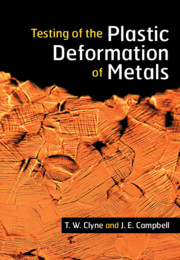Book contents
- Testing of the Plastic Deformation of Metals
- Reviews
- Testing of the Plastic Deformation of Metals
- Copyright page
- Contents
- Preface
- Nomenclature
- 1 General Introduction
- 2 Stresses, Strains and Elasticity
- 3 Continuum Plasticity
- 4 Mechanisms of Plastic Deformation in Metals
- 5 Tensile Testing
- 6 Compressive Testing
- 7 Hardness Testing
- 8 Indentation Plastometry
- 9 Nanoindentation and Micropillar Compression
- 10 Other Testing Geometries and Conditions
- Index
- References
3 - Continuum Plasticity
Published online by Cambridge University Press: 24 May 2021
- Testing of the Plastic Deformation of Metals
- Reviews
- Testing of the Plastic Deformation of Metals
- Copyright page
- Contents
- Preface
- Nomenclature
- 1 General Introduction
- 2 Stresses, Strains and Elasticity
- 3 Continuum Plasticity
- 4 Mechanisms of Plastic Deformation in Metals
- 5 Tensile Testing
- 6 Compressive Testing
- 7 Hardness Testing
- 8 Indentation Plastometry
- 9 Nanoindentation and Micropillar Compression
- 10 Other Testing Geometries and Conditions
- Index
- References
Summary
The handling of stress and strain during elastic deformation is covered in the preceding chapter. However, the situation becomes more complex after the onset of plastic deformation. Whereas elastic straining essentially occurs just via changes in interatomic spacing, the mechanisms involved in plastic (permanent) deformation are far from simple. These mechanisms are described in some detail in the next chapter. The current chapter is based, as is the previous one, on treating the material as a homogeneous continuum, albeit one that may be anisotropic (i.e. exhibit different responses in different directions). Much of the coverage concerns conditions for the onset of plasticity (often described as “yielding”) and subsequent rises in applied stress that are required for further plastic straining (“work hardening”). Two yielding criteria are in common use and these are described. The work-hardening behavior is often quantified using empirical constitutive laws and two of the most prominent of these are also outlined. This chapter also covers the representation of temporal effects – both the changes in stress–strain characteristics that occur when high strain rates are imposed and the progressive straining that can take place over long periods under constant stress, which is often termed “creep.”
Keywords
- Type
- Chapter
- Information
- Testing of the Plastic Deformation of Metals , pp. 21 - 42Publisher: Cambridge University PressPrint publication year: 2021



